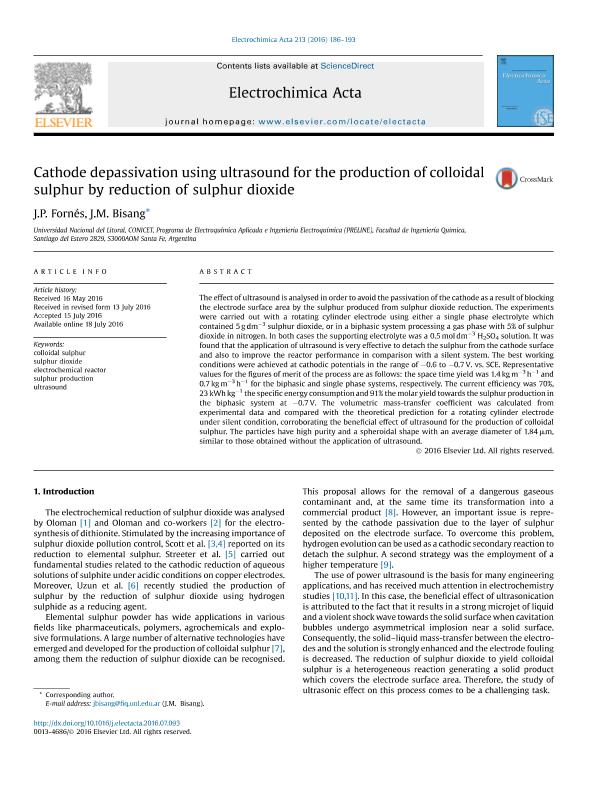Mostrar el registro sencillo del ítem
dc.contributor.author
Fornes, Juan Pablo

dc.contributor.author
Bisang, Jose Maria

dc.date.available
2019-02-27T20:35:02Z
dc.date.issued
2016-09
dc.identifier.citation
Fornes, Juan Pablo; Bisang, Jose Maria; Cathode depassivation using ultrasound for the production of colloidal sulphur by reduction of sulphur dioxide; Elsevier Science Ltd; Electrochimica Acta; 213; 9-2016; 186-193
dc.identifier.issn
0013-4686
dc.identifier.uri
http://hdl.handle.net/11336/70924
dc.description.abstract
The effect of ultrasound is analysed in order to avoid the passivation of the cathode as a result of blocking the electrode surface area by the sulphur produced from sulphur dioxide reduction. The experiments were carried out with a rotating cylinder electrode using either a single phase electrolyte which contained 5 g dm−3 sulphur dioxide, or in a biphasic system processing a gas phase with 5% of sulphur dioxide in nitrogen. In both cases the supporting electrolyte was a 0.5 mol dm−3 H2SO4 solution. It was found that the application of ultrasound is very effective to detach the sulphur from the cathode surface and also to improve the reactor performance in comparison with a silent system. The best working conditions were achieved at cathodic potentials in the range of −0.6 to −0.7 V. vs. SCE. Representative values for the figures of merit of the process are as follows: the space time yield was 1.4 kg m−3 h−1 and 0.7 kg m−3 h−1 for the biphasic and single phase systems, respectively. The current efficiency was 70%, 23 kWh kg−1 the specific energy consumption and 91% the molar yield towards the sulphur production in the biphasic system at −0.7 V. The volumetric mass-transfer coefficient was calculated from experimental data and compared with the theoretical prediction for a rotating cylinder electrode under silent condition, corroborating the beneficial effect of ultrasound for the production of colloidal sulphur. The particles have high purity and a spheroidal shape with an average diameter of 1.84 μm, similar to those obtained without the application of ultrasound.
dc.format
application/pdf
dc.language.iso
eng
dc.publisher
Elsevier Science Ltd
dc.rights
info:eu-repo/semantics/openAccess
dc.rights.uri
https://creativecommons.org/licenses/by-nc-nd/2.5/ar/
dc.subject
Colloidal Sulphur
dc.subject
Electrochemical Reactor
dc.subject
Sulphur Dioxide
dc.subject
Sulphur Production
dc.subject
Ultrasound
dc.subject.classification
Otras Ingeniería Química

dc.subject.classification
Ingeniería Química

dc.subject.classification
INGENIERÍAS Y TECNOLOGÍAS

dc.title
Cathode depassivation using ultrasound for the production of colloidal sulphur by reduction of sulphur dioxide
dc.type
info:eu-repo/semantics/article
dc.type
info:ar-repo/semantics/artículo
dc.type
info:eu-repo/semantics/publishedVersion
dc.date.updated
2019-02-27T12:50:55Z
dc.journal.volume
213
dc.journal.pagination
186-193
dc.journal.pais
Países Bajos

dc.journal.ciudad
Amsterdam
dc.description.fil
Fil: Fornes, Juan Pablo. Universidad Nacional del Litoral. Facultad de Ingeniería Química. Programa de Electroquímica Aplicada e Ingeniería Electroquímica; Argentina. Consejo Nacional de Investigaciones Científicas y Técnicas. Centro Científico Tecnológico Conicet - Santa Fe; Argentina
dc.description.fil
Fil: Bisang, Jose Maria. Universidad Nacional del Litoral. Facultad de Ingeniería Química. Programa de Electroquímica Aplicada e Ingeniería Electroquímica; Argentina. Consejo Nacional de Investigaciones Científicas y Técnicas. Centro Científico Tecnológico Conicet - Santa Fe; Argentina
dc.journal.title
Electrochimica Acta

dc.relation.alternativeid
info:eu-repo/semantics/altIdentifier/url/http://www.sciencedirect.com/science/article/pii/S0013468616315948
dc.relation.alternativeid
info:eu-repo/semantics/altIdentifier/doi/http://dx.doi.org/10.1016/j.electacta.2016.07.093
Archivos asociados
